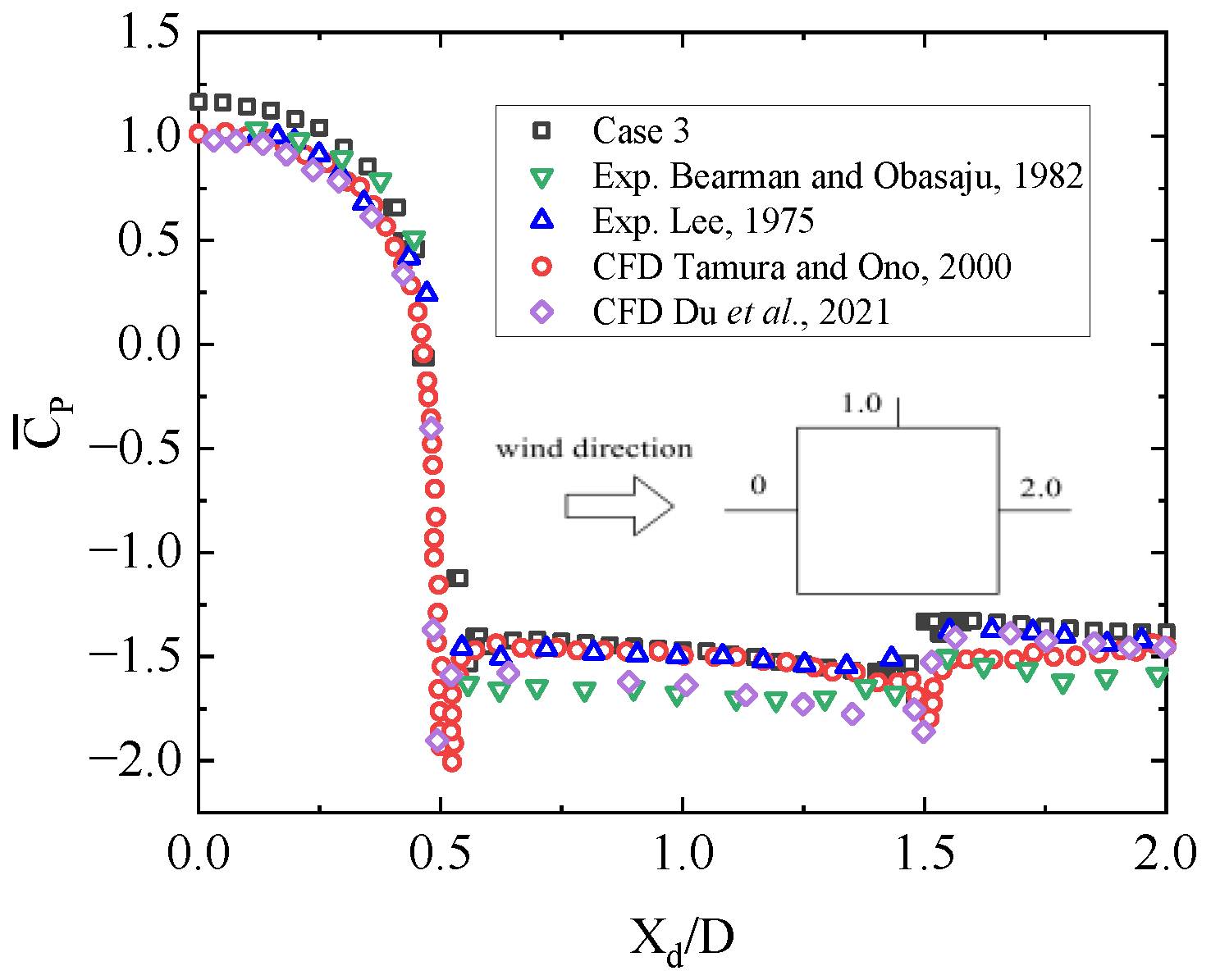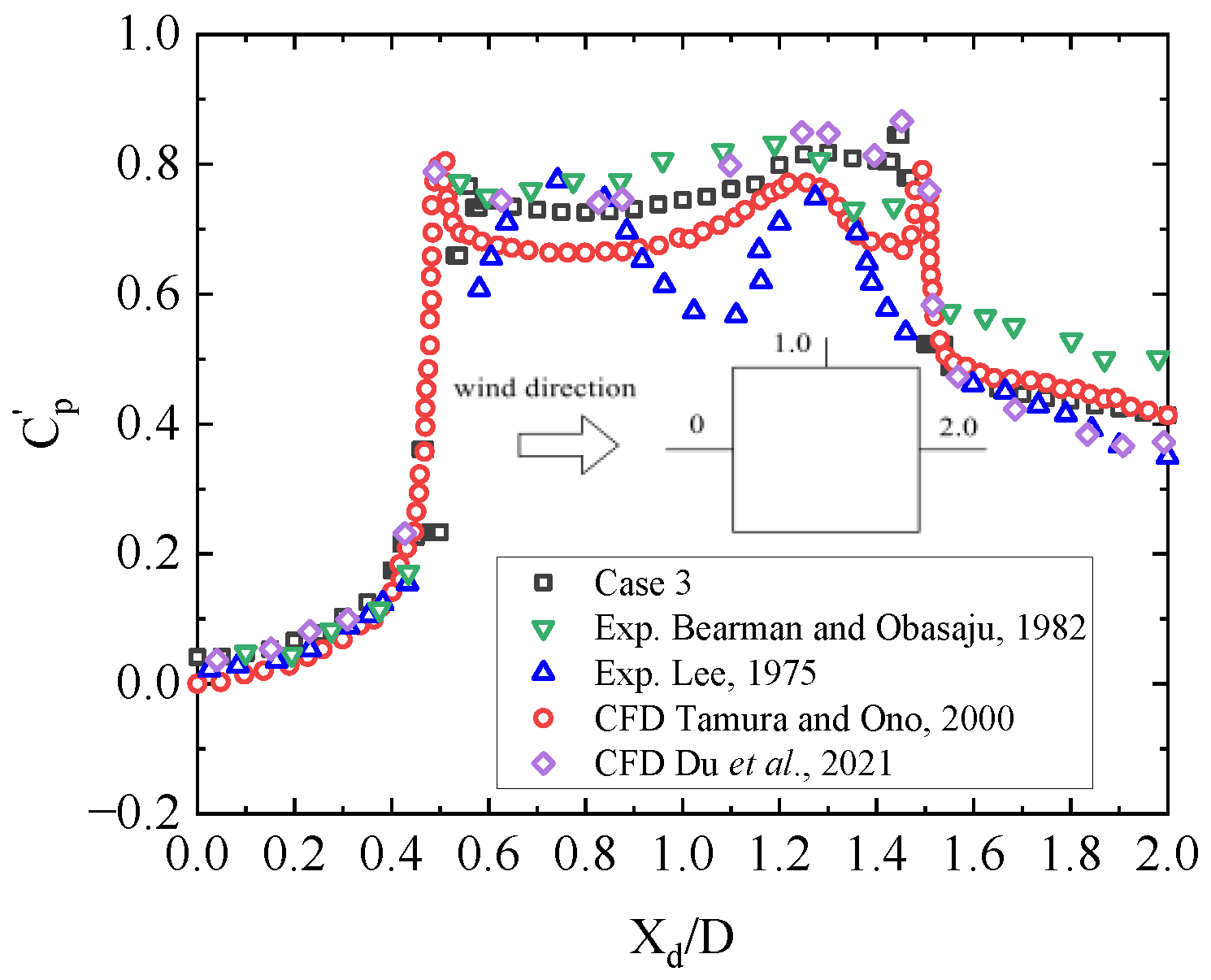Wind-Induced Interference Effect of Chamfered Square Cylinders in Tandem and Side-by-Side Arrangements
Abstract
:1. Introduction
2. Large Eddy Simulation and Data Processing Methods
2.1. Large Eddy Simulation
2.2. Numerical Details
2.3. Data Processing Method
3. Mesh Convergence Analysis and Result Verification
4. Aerodynamic Interference Effects
4.1. Pneumatic Interference Effect of Side-by-Side Square Cylinders
4.2. Interference Effect of Aerodynamic Coefficients of Tandem Square Cylinders
4.2.1. Interference Effect of Average Drag Coefficient
4.2.2. Interference Effect of Pulsating Lift Coefficient
5. Non-Gaussian Characteristics of Wind Pressure
5.1. Non-Gaussian Characteristics of Wind Pressure in Parallel Square Cylinders
5.2. Non-Gaussian Characteristics of Wind Pressure in Tandem Square Cylinders
6. Interference Effect of Wind Pressure
6.1. Interference Effect of Wind Pressure on Side-by-Side Square Cylinders with Cut Corners
6.1.1. Adjacent Elevation (Left Elevation)
6.1.2. Right Facade, Windward, and Leeward Sides
6.1.3. Corner Cutting
6.2. Interference Effect of Tandem Square Cylinder with Chamfered Angle
7. Conclusions
- The aerodynamic interference effect of the square cylinder is sensitive to the change of the chamfer. Compared with the standard square cylinder, the aerodynamic coefficient of the chamfered square cylinder is significantly reduced. When 1.5 ≤ B/L < 2.5, the aerodynamic coefficients of the perturbed square cylinders in tandem mode are reduced, the mean drag coefficients in juxtaposition mode are magnified, and the pulsatile lift coefficients are reduced. When 2.5 ≤ B/L ≤ 8.0, the aerodynamic coefficients in all modes show a decreasing effect. The critical spacing ratio of the aerodynamic coefficients of the tandem square cylinders after chamfering is 2.5~3.0, which is smaller than the critical spacing ratio of 3.0~4.5 for standard square cylinders.
- Based on other literature, a criterion for the division of non-Gaussian regions is defined in this paper. This is when the absolute value of skewness is greater than 0.2, the absolute value of kurtosis is greater than 3.5, the absolute value of skewness is greater than 0.45, and the absolute value of kurtosis is greater than 4.0. The juxtaposed square cylinders have no obvious characteristics and tend to be single square cylinders when the spacing ratio gradually increases. When the spacing ratio of the tandem square cylinders is less than the critical spacing ratio, the non-Gaussian area of the structure gradually decreases. Additionally, the non-Gaussian region division undergoes abrupt changes when the spacing ratio reaches the critical spacing ratio. Finally, the windward surface shows a Gaussian distribution, and the leeward, left, and right facades all appear in the non-Gaussian regions.
- Chamfering magnifies the wind pressure interference effect between square cylinders and makes the interference spread more widely. For juxtaposed square cylinders, when B/L = 1.2, the upwind face shows a magnifying effect, while the other facades and tangential angles show a decreasing effect. When B/L = 1.5, the interference factor of the disturbed square cylinder reaches a maximum of 2.58, which is located at the tangent angle c of the rear flow field on the adjacent side. When B/L ≥ 2.5, the interference effects of other facades and tangent angles tend to disappear, except for the left facet. The left facet still has a large interference effect. When B/L = 8.0, there is still a 28% interference effect on the adjacent facades of two square cylinders. For tandem square cylinders, the downstream square cylinder is affected by the “Shelter effect” of the upstream square cylinder. The windward surface wind pressure is the wind suction. The interference factor in this case is negative, and the maximum value is 2.31. When 1.5 ≤ C/L ≤ 2.5, the leeward, left, and right elevations all show a significant reduction effect. When the spacing ratio reaches the critical spacing ratio, the interference factor increases suddenly, but there is still a decreasing effect.
Author Contributions
Funding
Institutional Review Board Statement
Informed Consent Statement
Data Availability Statement
Acknowledgments
Conflicts of Interest
References
- Armitt, J. Wind loading on cooling towers. J. Struct. Div. 1980, 106, 623–641. [Google Scholar] [CrossRef]
- Liu, Z. Study on the Law of Interference Effect between High-Rise Buildings on Wind Induced Pressure and Acceleration; Harbin Institute of Technology: Harbin, China, 2019. [Google Scholar]
- Luo, S.C.; Yazdani, M.G.; Chew, Y.T.; Lee, T.S. Effects of incidence and after body shape on flow past bluff cylinders. J. Wind Eng. Ind. Aerodyn. 1994, 53, 375–399. [Google Scholar] [CrossRef]
- Lyn, D.A.; Einav, S.; Rodi, W.; Park, J.H. A laser-Doppler velocimetry study of ensemble-averaged characteristics of the turbulent near wake of a square cylinder. J. Fluid Mech. 2006, 304, 285–319. [Google Scholar] [CrossRef]
- Bearman, P.W.; Obasaju, E.D. An experimental study of pressure fluctuations on fixed and oscillating square-section cylinders. J. Fluid Mech. 1982, 119, 297–321. [Google Scholar] [CrossRef]
- Lee, B.E. The effect of turbulence on the surface pressure field of a square prism. J. Fluid Mech. 2006, 69, 263–282. [Google Scholar] [CrossRef]
- Rodi, W.; Ferziger, J.H.; Breuer, M.; Pourquie, M. Status of large-eddy simulation: Results of a workshop. J. Fluid Mech. 1997, 119, 248–262. [Google Scholar] [CrossRef]
- Cao, Y.; Tamura, T. Large-eddy simulations of flow past a square cylinder using structured and unstructured grids. Comput. Fluids 2016, 137, 36–54. [Google Scholar] [CrossRef]
- Rodi, W. Comparison of LES and RANS calculations of the flow around bluff bodies. J. Wind Eng. Ind. Aerodyn. 1997, 69–71, 55–75. [Google Scholar] [CrossRef]
- Grigoriadis, D.G.E.; Bartzis, J.G.; Goulas, A. LES of the flow past a rectangular cylinder using the immersed boundary concept. Int. J. Numer. Methods Fluids 2003, 41, 615–632. [Google Scholar] [CrossRef]
- Tamura, T.; Ono, Y. LES analysis on aeroelastic instability of prisms in turbulent flow. J. Wind Eng. Ind. Aerodyn. 2003, 91, 1827–1846. [Google Scholar] [CrossRef]
- Du, X.; Shi, D.; Dong, H.; Li, Y. Flow around square-like cylinders with corner and side modifications. J. Wind Eng. Ind. Aerodyn. 2021, 215, 104686. [Google Scholar] [CrossRef]
- Gu, M.; Xie, Z.N. Interference effects of two and three super-tall buildings under wind action. Acta Mech. Sin. 2011, 27, 687–696. [Google Scholar] [CrossRef]
- Mara, T.G.; Terry, B.K.; Ho, T.C.; Isyumov, N. Aerodynamic and peak response interference factors for an upstream square building of identical height. J. Wind Eng. Ind. Aerodyn. J. Int. Assoc. Wind Eng. 2014, 133, 200–210. [Google Scholar] [CrossRef]
- Long, D.S.; Yamada, H.; Katsuchi, H. Interference effects of wind-over-top flow on high-rise buildings. J. Wind Eng. Ind. Aerodyn. 2019, 187, 85–96. [Google Scholar] [CrossRef]
- Lo, Y.L.; Kim, Y.C.; Li, Y.C. Downstream interference effect of high-rise buildings under turbulent boundary layer flow. J. Wind Eng. Ind. Aerodyn. 2016, 159, 19–35. [Google Scholar] [CrossRef]
- Yu, X.F.; Xie, Z.N.; Wang, X.; Cai, B. Interference effects between two high-rise buildings on wind-induced torsion. J. Wind Eng. Ind. Aerodyn. 2016, 159, 123–133. [Google Scholar] [CrossRef]
- Yu, X.; Xie, Z.; Gu, M. Interference effects between two tall buildings with different section sizes on wind-induced acceleration. J. Wind Eng. Ind. Aerodyn. 2018, 182, 16–26. [Google Scholar] [CrossRef]
- Kim, W.; Tamura, Y.; Yoshida, A. Interference effects on aerodynamic wind forces between two buildings. J. Wind Eng. Ind. Aerodyn. 2015, 147, 186–201. [Google Scholar] [CrossRef]
- Kataoka, H. Numerical simulations of a wind-induced vibrating square cylinder within turbulent boundary layer. J. Wind Eng. Ind. Aerodyn. 2008, 96, 1985–1997. [Google Scholar] [CrossRef]
- Hui, Y.; Tamura, Y.; Yoshida, A. Mutual interference effects between two high-rise building models with different shapes on local peak pressure coefficients. J. Wind Eng. Ind. Aerodyn. 2012, 104, 98–108. [Google Scholar] [CrossRef]
- Hui, Y.; Tamura, Y.; Yang, Q.S. Analysis of interference effects on torsional moment between two high-rise buildings based on pressure and flow field measurement. J. Wind Eng. Ind. Aerodyn. 2017, 164, 54–68. [Google Scholar] [CrossRef]
- Yan, B.W.; Li, Q.S. Wind tunnel study of interference effects between twin super-tall buildings with aerodynamic modifications. J. Wind Eng. Ind. Aerodyn. 2016, 156, 129–145. [Google Scholar] [CrossRef]
- Bin, L.; Ren, J. Vortex-induced vibrations of a rectangular cylinder. Ocean Eng. 2022, 266, 112883. [Google Scholar] [CrossRef]
- Ming, Z.; Teng, W.; Ole, Ø. Vortex-induced vibration control of a flexible circular cylinder using a nonlinear energy sink. J. Wind. Eng. Ind. Aerodyn. 2022, 229, 105163. [Google Scholar] [CrossRef]
- Bo, W.; Ming, Z.; Fu, X. Experimental investigation on the vortex-induced vibration of a rectangular 4:1 cylinder under skew winds. J. Wind Eng. Ind. Aerodyn. 2022, 229, 105114. [Google Scholar] [CrossRef]
- Tamura, T.; Miyagi, T.; Kitagishi, T. Numerical prediction of unsteady pressures on a square cylinder with various corner shapes. J. Wind Eng. Ind. Aerodyn. 1998, 74, 531–542. [Google Scholar] [CrossRef]
- Gu, M.; Quan, Y. Across-wind loads of typical tall buildings. J. Wind Eng. Ind. Aerodyn. 2004, 92, 1147–1165. [Google Scholar] [CrossRef]
- Hayashida, H.; Iwasa, Y. Aerodynamic shape effects of tall building for vortex induced vibration. J. Wind Eng. Ind. Aerodyn. 1990, 33, 237–242. [Google Scholar] [CrossRef]
- Miyashita, K.; Katagiri, J.; Nakamura, O.; Ohkuma, T.; Tamura, Y.; Itoh, M.; Mimachi, T. Wind-induced response of high-rise buildings Effects of corner cuts or openings in square buildings. J. Wind Eng. Ind. Aerodyn. 1993, 50, 319–328. [Google Scholar] [CrossRef]
- Kwok, K.; Wilhelm, P.A.; Wilkie, B.G. Effect of edge configuration on wind-induced response of tall buildings. Eng. Struct. 1988, 10, 135–140. [Google Scholar] [CrossRef]
- Zheng, D.; Liu, S.; Ma, W.; Chen, H. Large eddy simulation for effects of chamfering and corner cut on aerodynamic performance of square cylinder. J. Vib. Shock. 2021, 40, 8–14. [Google Scholar] [CrossRef]
- Tanaka, H.; Tamura, Y.; Ohtake, K.; Nakai, M.; Yong, C.K. Experimental investigation of aerodynamic forces and wind pressures acting on tall buildings with various unconventional configurations. J. Wind Eng. Ind. Aerodyn. 2012, 107, 179–191. [Google Scholar] [CrossRef]
- Kawai, H. Effect of corner modifications on aeroelastic instabilities of tall buildings. J. Wind Eng. Ind. Aerodyn. 1998, 74, 719–729. [Google Scholar] [CrossRef]
- Wang, X.; Gu, M. Experimental study on wind pressure distributions of 2-D square prisms with various corner treatments. China Civ. Eng. J. 2016, 49, 79–88. [Google Scholar] [CrossRef]
- Nicoud, F.; Ducros, F. Subgrid-Scale Stress Modelling Based on the Square of the Velocity Gradient Tensor. Flow Turbul. Combust. 1999, 62, 183–200. [Google Scholar] [CrossRef]
- Yu, X.F.; Xie, Z.N.; Zhu, J.B.; Gu, M. Interference effects on wind pressure distribution between two high-rise buildings. J. Wind Eng. Ind. Aerodyn. 2015, 142, 188–197. [Google Scholar] [CrossRef]
- Kumar, K.S.; Stathopoulos, T. Computer simulation of fluctuating wind pressures on low building roofs. J. Wind Eng. Ind. Aerodyn. 1997, 69, 485–495. [Google Scholar] [CrossRef]
- Sun, Y.; Wu, Y.; Lin, Z.; Shen, S. Non-Gaussian features of fluctuating wind pressure sonlong span roofs. China Civ. Eng. J. 2007, 40, 1–5. [Google Scholar] [CrossRef]
- Lou, W.; Li, J.; Shen, G. Non -Gaussian feature of wind-induced pressure on super-tall building. J. Zhejiang Univ. 2011, 45, 671–677. [Google Scholar] [CrossRef]
- Han, N.; Gu, M. Analysis on non -Gaussian features of fluctuating wind pressure on square tall buildings. J. Tongji Univ. 2012, 40, 971–976. [Google Scholar] [CrossRef]

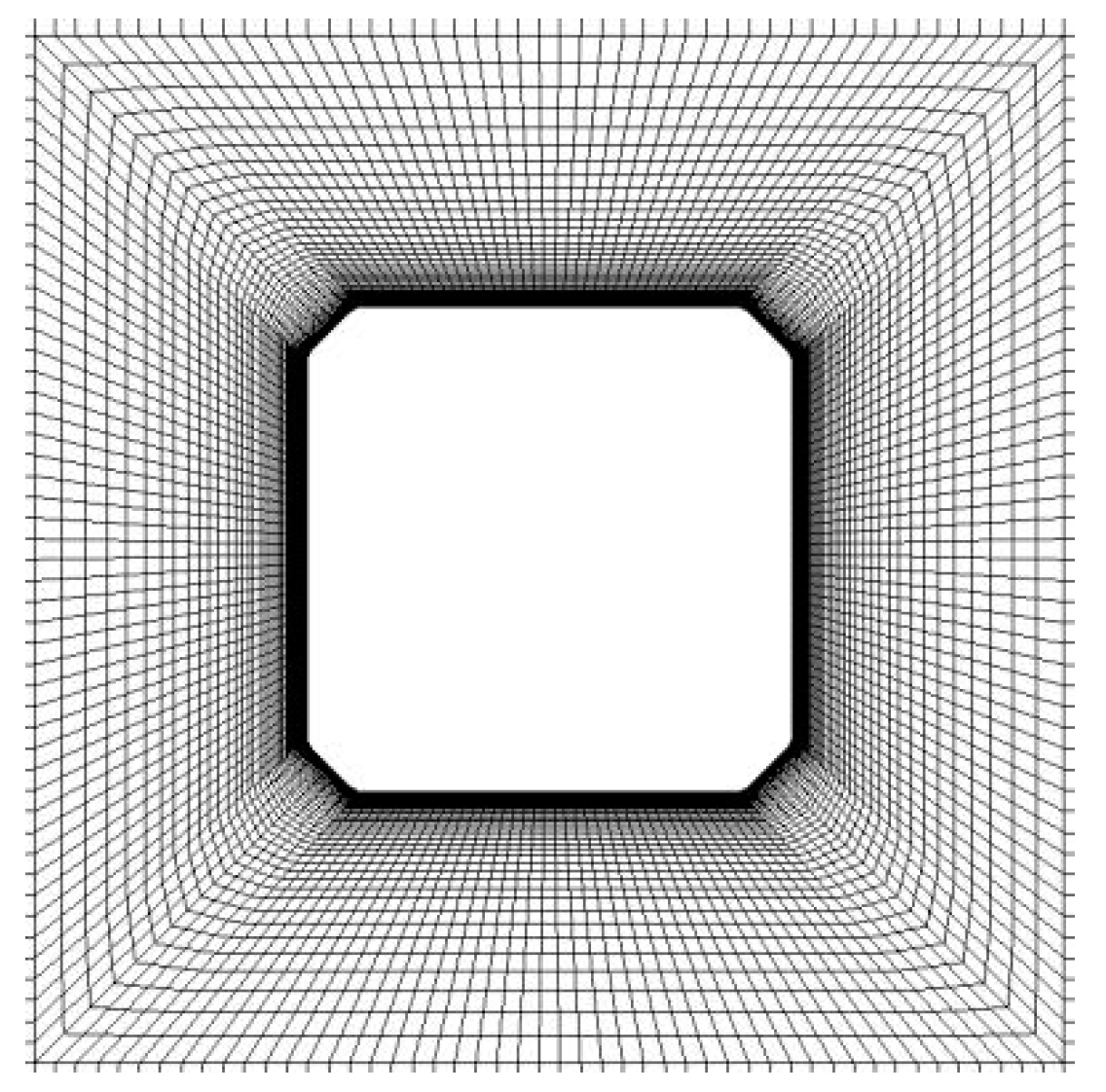

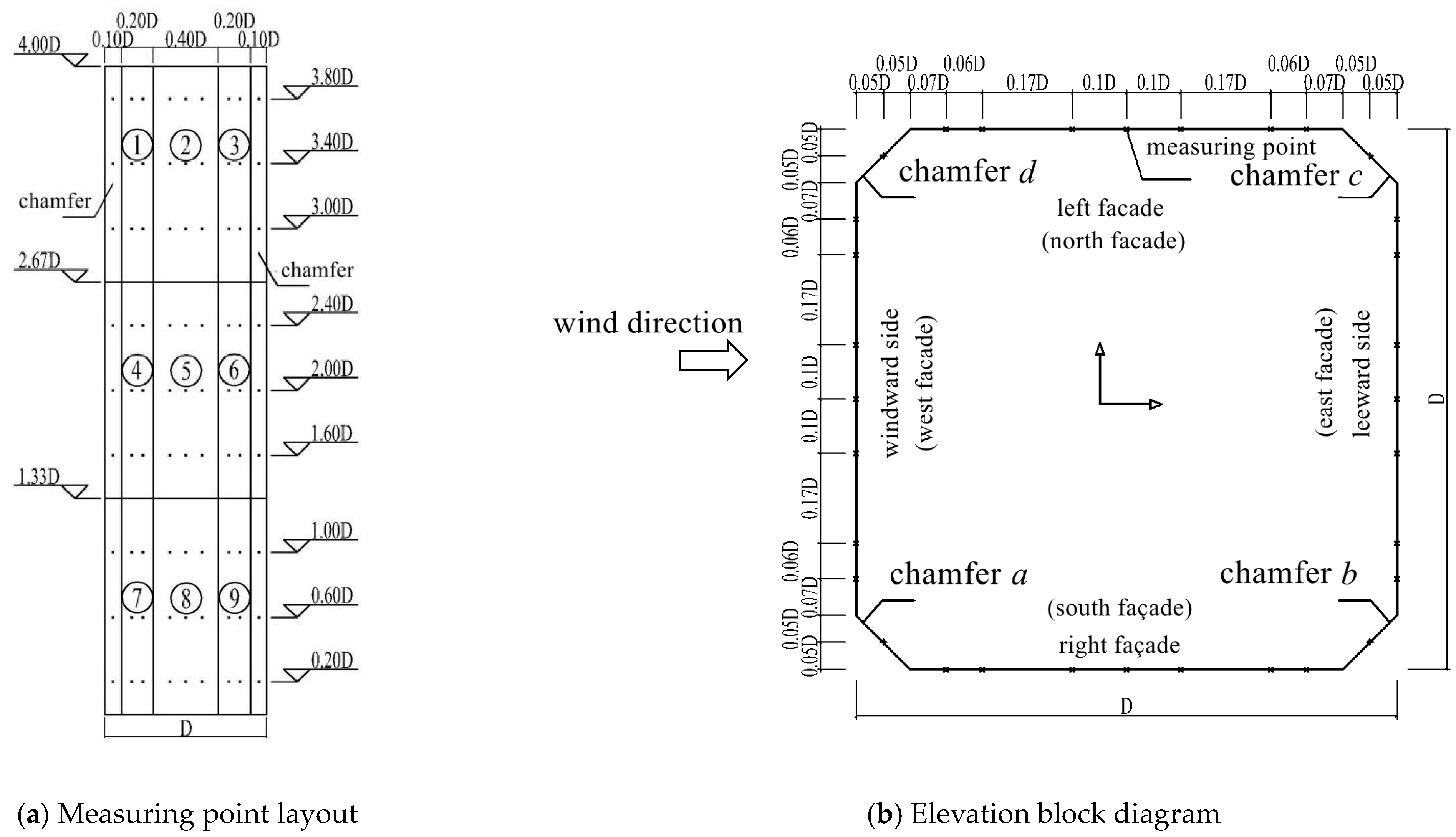
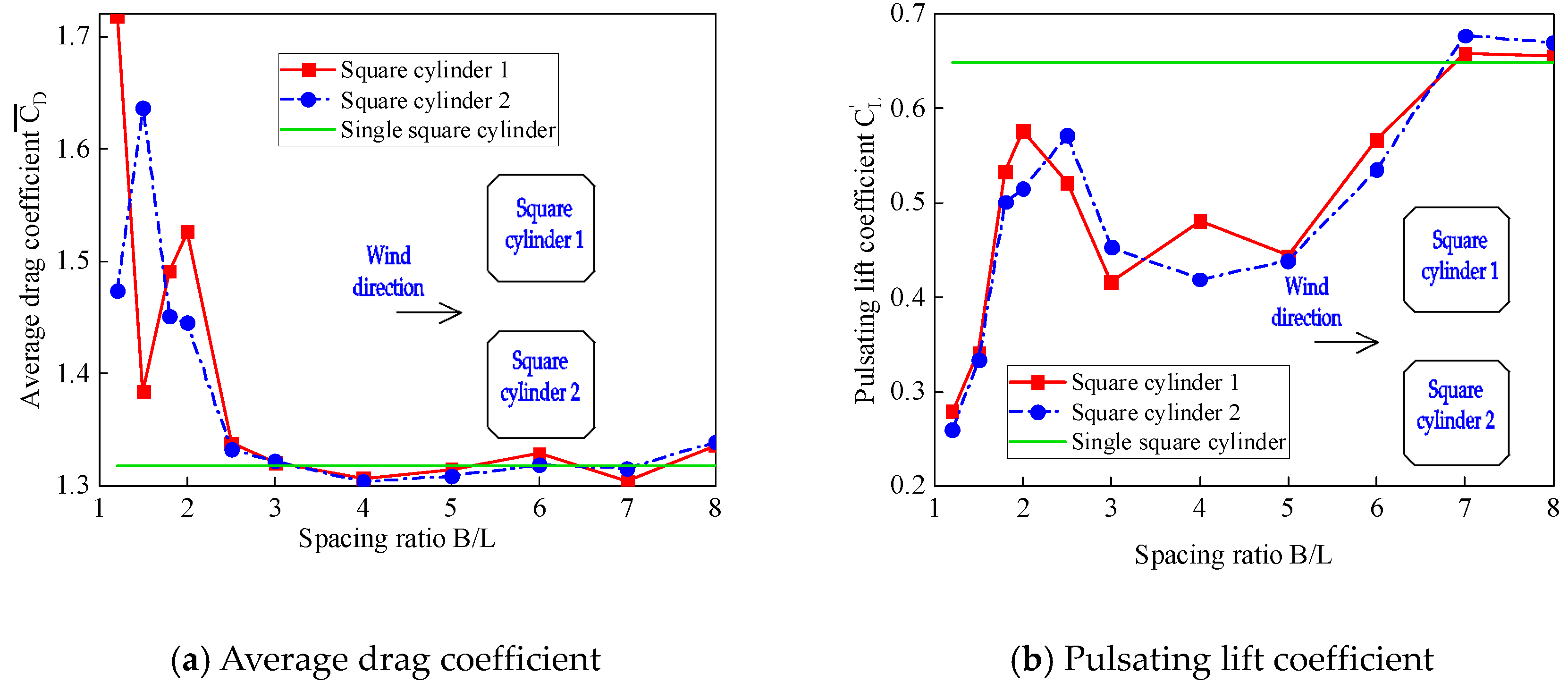


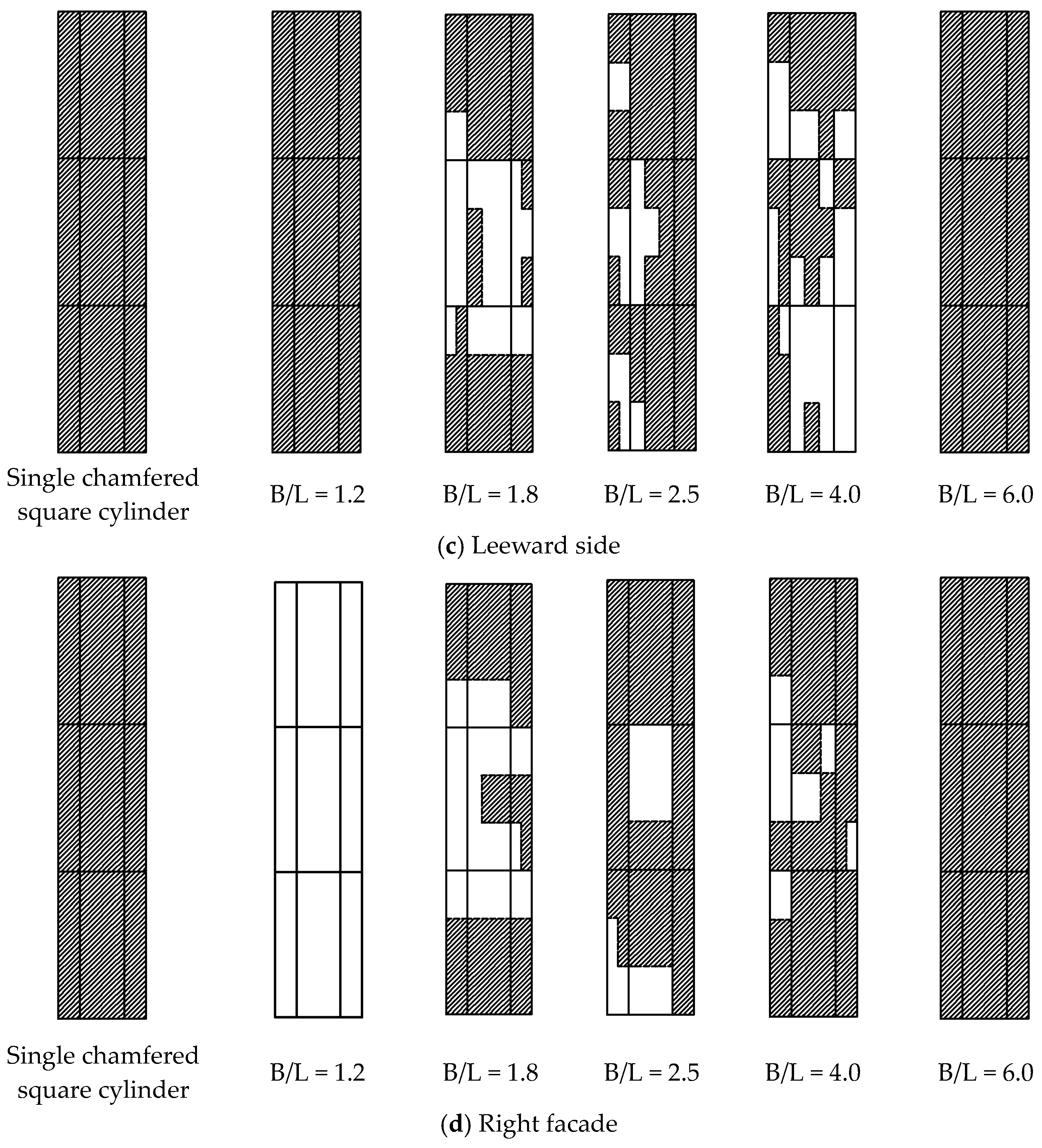
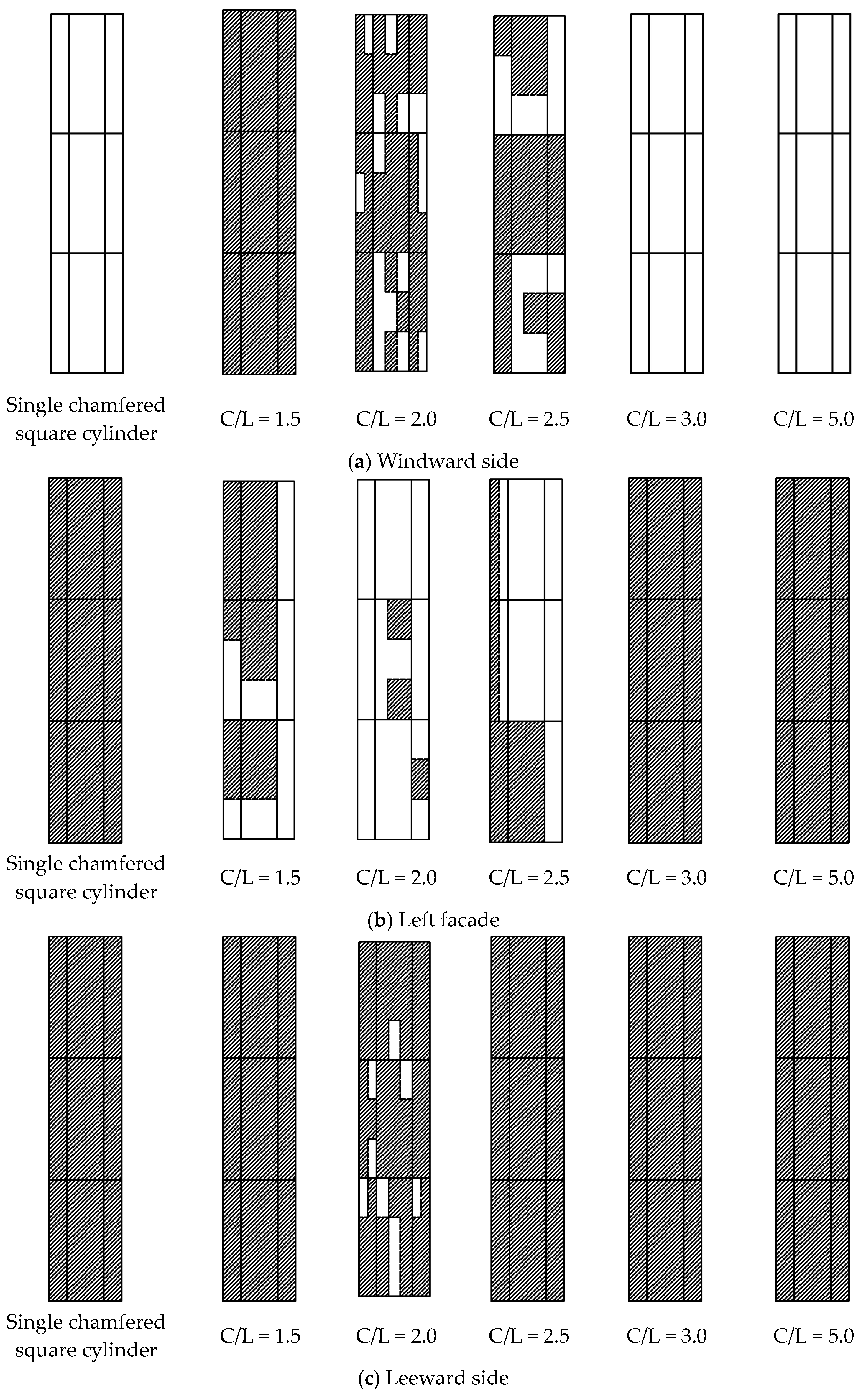
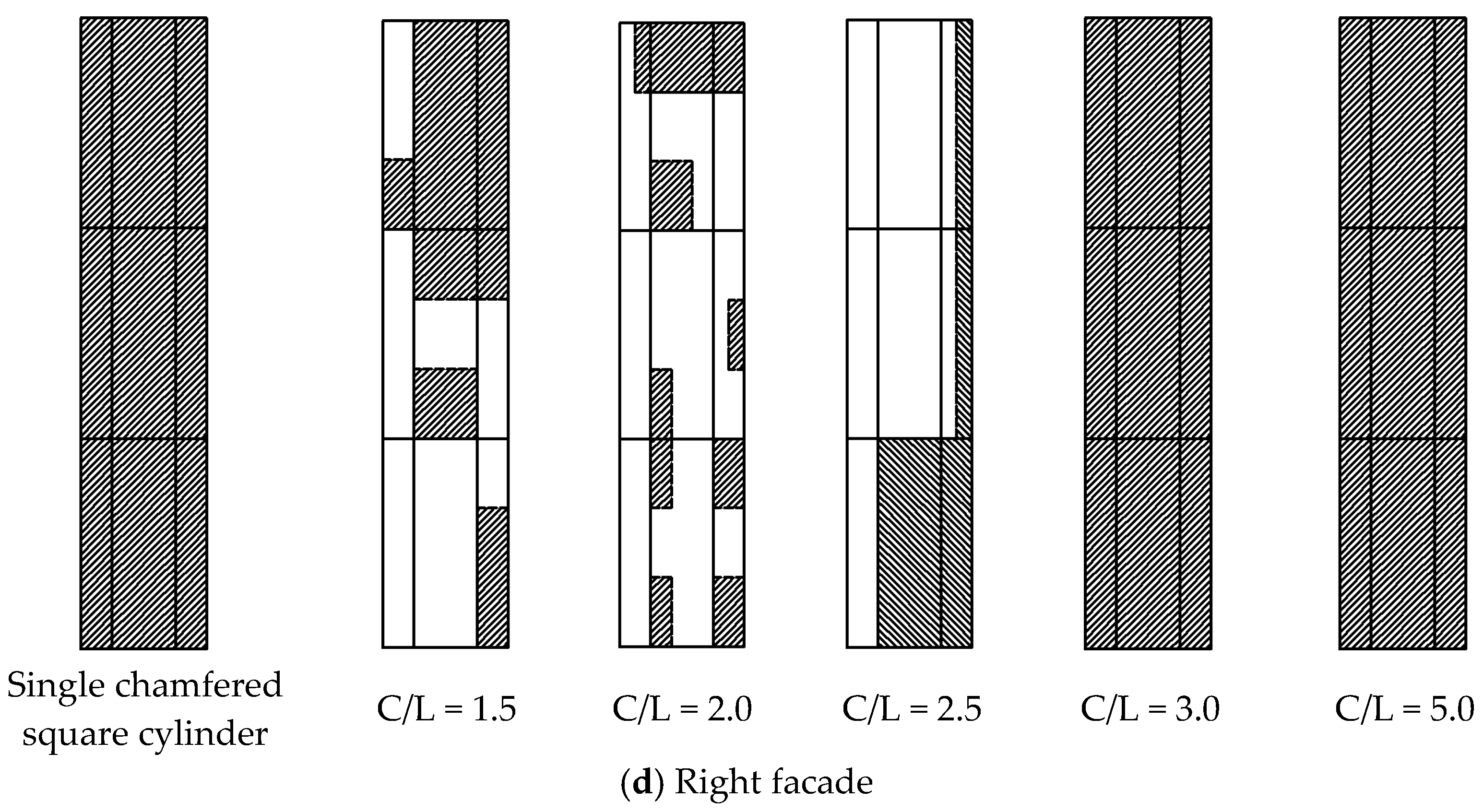
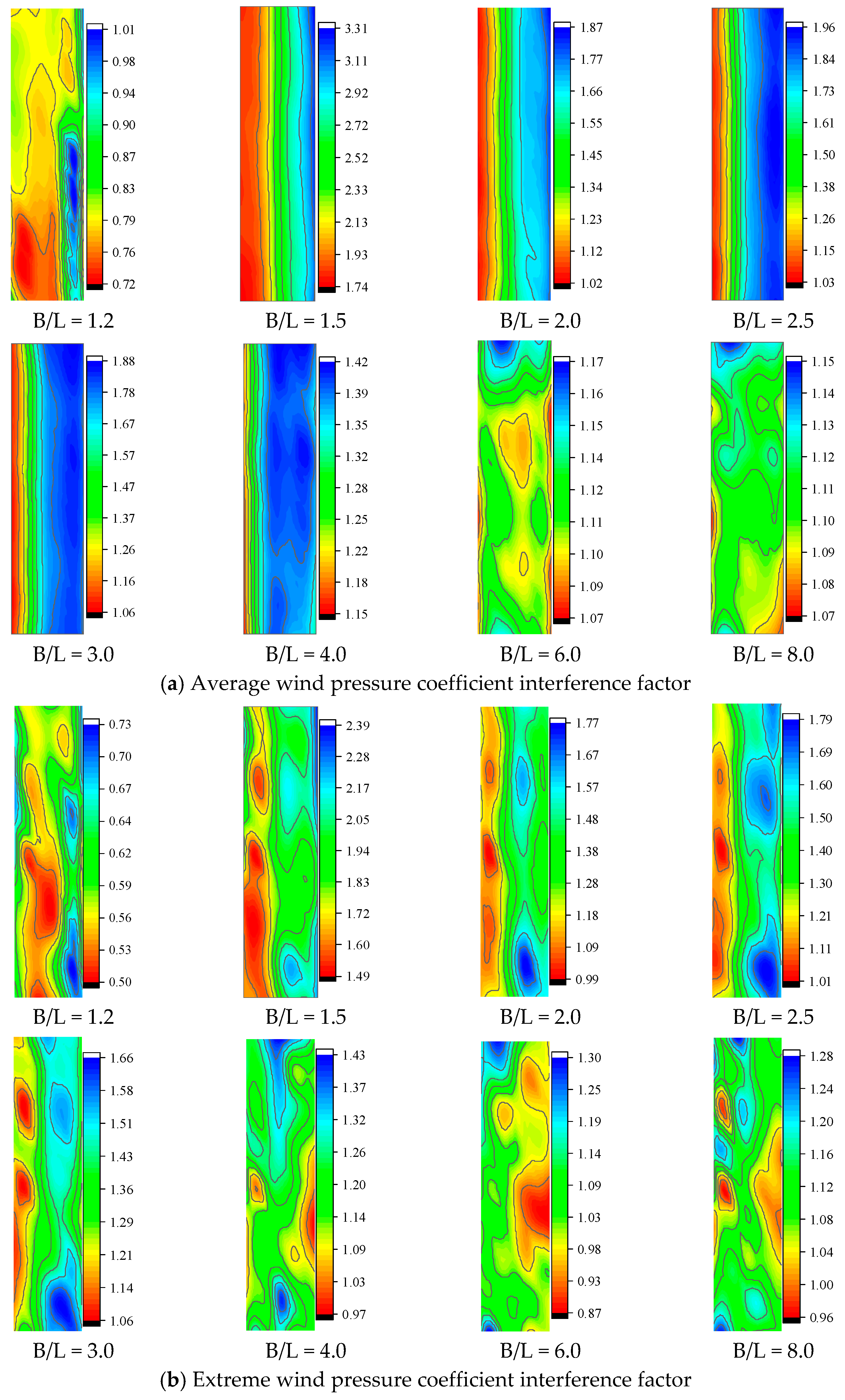

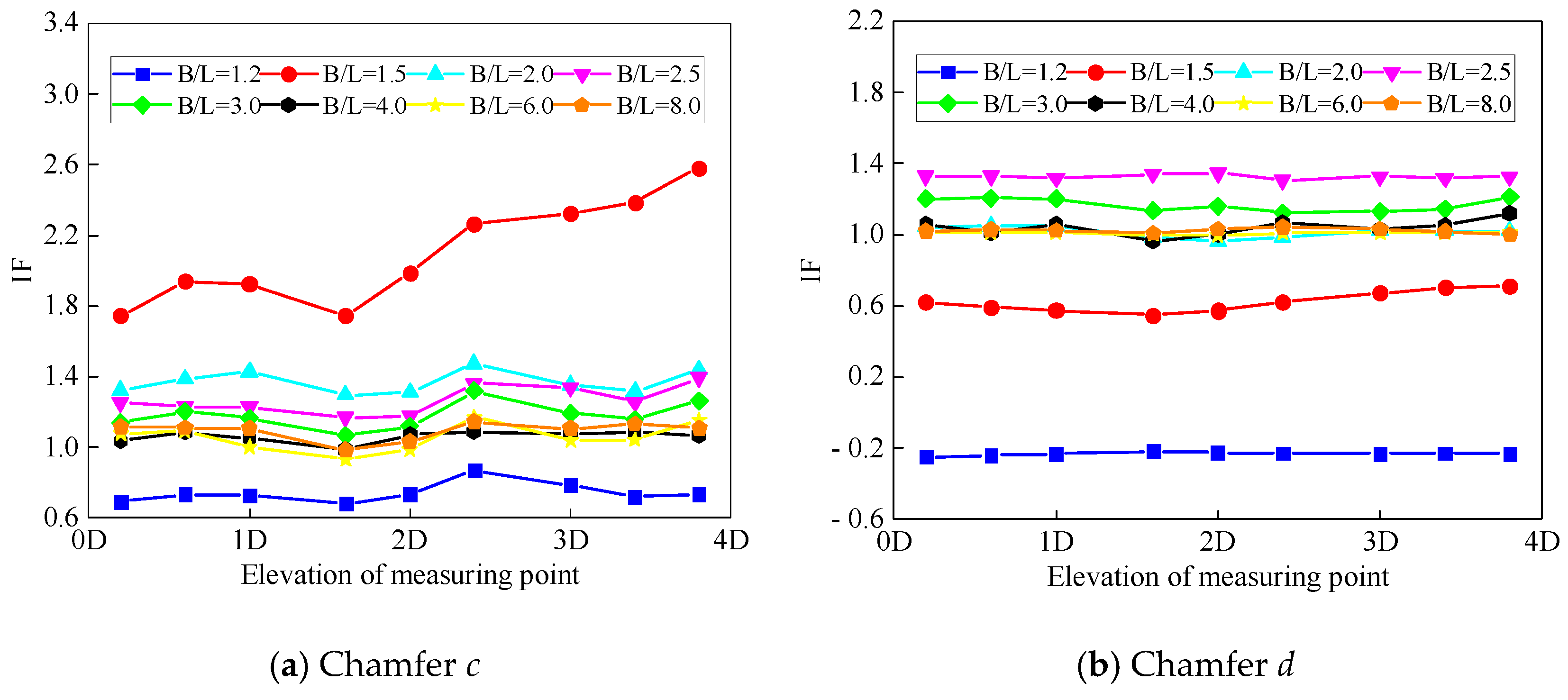
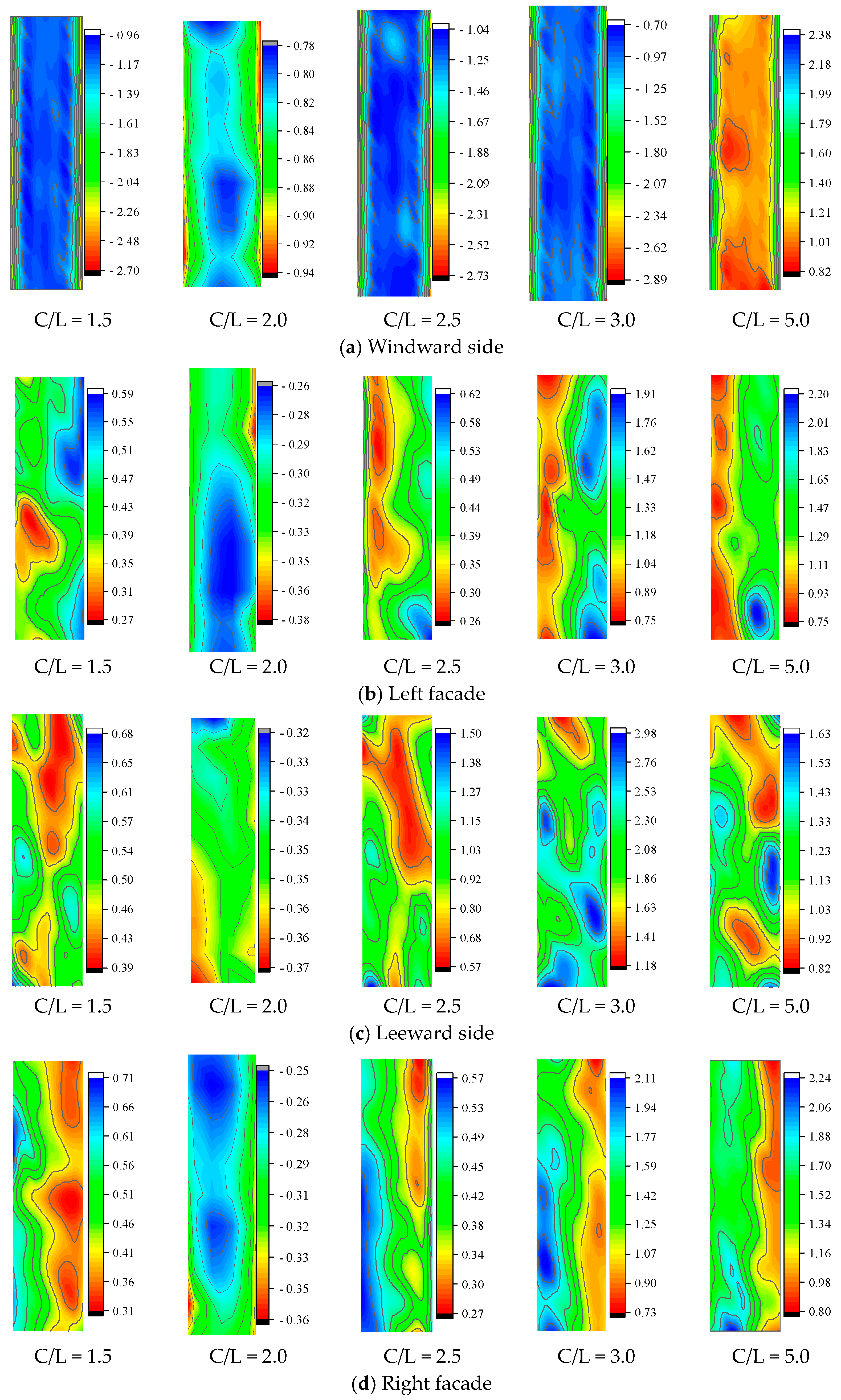
| Program | First Layer Grid Size | Wall y+ | Number of Grids | Average Drag Coefficient | Pulsating Lift Coefficient | Strouhal Number |
|---|---|---|---|---|---|---|
| Case 1 | 1 × 10−2 L | <10 | 5.6 × 105 | 2.058 | 0.842 | 0.132 |
| Case 2 | 1 × 10−3 L | <2.5 | 9.5 × 105 | 2.272 | 1.339 | 0.130 |
| Case 3 | 5 × 10−4 L | <1 | 1.4 × 106 | 2.269 | 1.428 | 0.131 |
| Case 4 | 1 × 10−4 L | <0.25 | 1.8 × 106 | 2.372 | 1.365 | 0.132 |
| Exp [3] | — | — | — | 2.210 | 1.260 | 0.130 |
| Exp [4] | — | — | — | 2.100 | 1.600 | 0.132 |
| Exp [5] | — | — | — | — | 1.200 | 0.130 |
| Exp [6] | — | — | — | 2.050 | 1.220 | 0.120 |
| CFD [7] | — | — | — | 2.300 | 1.150 | 0.130 |
| CFD [8] | — | — | — | 2.110–2.300 | 1.260–1.540 | 0.130–0.140 |
| CFD [9] | — | — | — | 2.020–2.270 | 1.150–1.790 | 0.090–0.150 |
Publisher’s Note: MDPI stays neutral with regard to jurisdictional claims in published maps and institutional affiliations. |
© 2022 by the authors. Licensee MDPI, Basel, Switzerland. This article is an open access article distributed under the terms and conditions of the Creative Commons Attribution (CC BY) license (https://creativecommons.org/licenses/by/4.0/).
Share and Cite
Zhang, J.; Li, F.; Zhang, Z.; Zhang, T.; Wang, C.; Xiang, B.; Zhang, Y. Wind-Induced Interference Effect of Chamfered Square Cylinders in Tandem and Side-by-Side Arrangements. Buildings 2022, 12, 2125. https://doi.org/10.3390/buildings12122125
Zhang J, Li F, Zhang Z, Zhang T, Wang C, Xiang B, Zhang Y. Wind-Induced Interference Effect of Chamfered Square Cylinders in Tandem and Side-by-Side Arrangements. Buildings. 2022; 12(12):2125. https://doi.org/10.3390/buildings12122125
Chicago/Turabian StyleZhang, Jie, Fanghui Li, Zhibo Zhang, Te Zhang, Cheng Wang, Benjun Xiang, and Yuji Zhang. 2022. "Wind-Induced Interference Effect of Chamfered Square Cylinders in Tandem and Side-by-Side Arrangements" Buildings 12, no. 12: 2125. https://doi.org/10.3390/buildings12122125
APA StyleZhang, J., Li, F., Zhang, Z., Zhang, T., Wang, C., Xiang, B., & Zhang, Y. (2022). Wind-Induced Interference Effect of Chamfered Square Cylinders in Tandem and Side-by-Side Arrangements. Buildings, 12(12), 2125. https://doi.org/10.3390/buildings12122125




